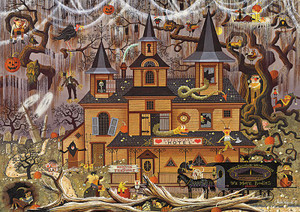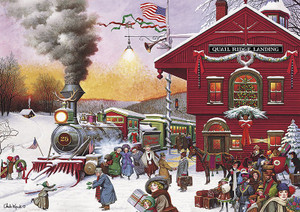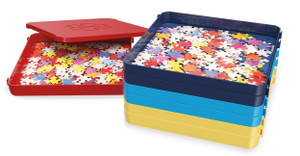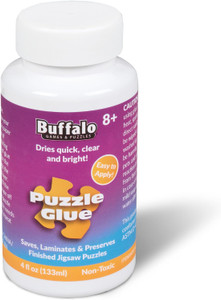Posted by Buffalo Games on Apr 6th 2022
How Long Does It Take to Do a 300-Piece Jigsaw Puzzle?
Many things influence how long it will take a person to complete jigsaw puzzles. While there are some tips and tricks that can help speed up completion time while reducing frustration, there are still many different things that pull together to determine your finish time.
On average, standard 300-piece puzzles can take two to three hours for a person to complete. Usually, these jigsaws have larger-than-average sized pieces, making them excellent for children, the elderly, people with Alzheimer’s or dementia, and families who like to do puzzles together.
Completion Times for Other Puzzles
Expected solving times for other sizes of popular puzzles also vary according to many factors, just as they do for 300-piece puzzles. In general, the time it takes to solve different sizes of puzzles is as follows:
●500-piece puzzles: 2-7 hours, with an average of 4 hours
●1,000-piece puzzles: 5-12 hours, with an average of 9 hours
●2,000-piece puzzles: 11-24 hours, with an average of 17 hours
The most significant single indicator of how long a puzzle will take to complete is the number of pieces included in the puzzle. While some people claim that every time the number of pieces is doubled, the time also required doubles, others argue that the time needed to finish is quadrupled for every doubling in pieces.
What Determines Puzzle Completion Time?
Whether it’s a children’s puzzle with 25 large pieces or one of the many jigsaw puzzles for adults with 2,000 pieces, no two puzzlers (people who solve puzzles) will solve them the same way or within the same time.
Other than the number of pieces, some of the other factors that will determine how long a 300-piece puzzle takes to finish include:
●The experience of the puzzler
●How many people will work on the puzzle
●The complexity of the patterns on the pieces
●The strategy for assembly
●The actual cut of the pieces
Puzzles that have an irregular finished shape and those with tiny pieces usually take much longer to complete than standard 300-piece puzzles. If a puzzler has previously completed a puzzle, the time to finish it will be reduced.
While the number of people working on a puzzle is a factor that doesn’t need much explanation, the other factors may require a bit more detail.
The Experience of the Puzzler
Avid jigsaw puzzle enthusiasts who solve puzzles regularly have two significant advantages over inexperienced puzzlers:
●They have had time to develop and perfect their strategies
●Repeated solving has sharpened their cognitive skills and puzzling skills
However, it’s important to remember that even the world-record-holder puzzle-solvers still had to start as beginners at one time!
The Complexity of the Patterns on the Pieces
This factor is interesting because people often think at first that the fewer colors there are in a puzzle, the easier it would be to put together. However, if you think about it, it makes more sense that a puzzle with just one lonely color would be more complex than a puzzle with ten colors, right?
The single-color puzzle has no pattern to help you discern which pieces go where. However, the puzzle with ten colors would provide clues by matching colors up to help make puzzling easier.
At the other extreme are jigsaw puzzles with dozens of different shades, patterns, designs, and colors. When there are “too many” colors and patterns, the task begins to go back the other way from “easier with patterns” to “too many patterns to make sense of.”
The Strategy for Assembly
Whether it applies to 100-piece puzzles, 500-piece puzzles, or 1,000-piece jigsaw puzzles, a person's strategy also makes a big difference in completion time. Part of that strategy is preparation!
Prepare
Prep for your 300-piece puzzles accordingly. Take a few minutes to collect some puzzle accessories to help you out, including a roll-up puzzle mat, some peel-and-stick adhesive, and sorting trays to keep loose pieces nice and organized.
Lighting
Don’t disregard the lighting in your workspace; you want bright light that won’t cast shadows on the pieces. A floor lamp is poor because of shadows, but an overhead light works very well.
Measure
Leave a few inches (minimum) of space on all sides of the puzzle; the box should tell you the finished size, so take some measurements to make sure your work area is large enough.
Organize
Sort your pieces according to colors and patterns. Many people like to separate the outer edge pieces before starting with those. Once they’ve completed the outer edges, they find it helpful to work their way inwards toward the center.
Missing Pieces
Many puzzlers mistake taking much time searching for one specific piece of a 300-piece puzzle, especially if it is the last one needed to complete a section. Don’t do this; you’ll get frustrated and waste time.
When pieces can’t be found, a good strategy is to search for a few minutes, then move on to another section. That sneaky missing piece will eventually turn up!
The Actual Cut of the Pieces
In general, the more curves and rounds a puzzle piece has, the more challenging it will be to find the pieces that fit along with it.
There are no complete classification terms for cutting designs of pieces. The cuts of pieces have many names, but most people call them tabs and blanks.
Other names for the tabs include loops, outies, keys, knobs, and bumps. They’re also sometimes called the male sides.
Additional names for the blanks are sockets, slots, locks, pockets, and female sides.
Picking Out Great 300-Piece Puzzles
If you have a few quiet hours on your hands, a 300-piece puzzle is great to fill the time. Puzzles offer a variety of benefits, from reducing stress to improving cognition to serving as a means of bringing the whole family together. Which puzzles you ultimately choose is entirely up to you!


















































